Peridot
Peridot is the name for the gem quality members of the olivine group, a group of miscible silicates with isomorphous replacement.
The endmembers of the olivine group are an iron silicate called fayalite and tephroit, a manganese silicate. Other members are forsterite, glaucochroite, kirschsteinite, laihunite, monticellite and the calcium-dominant calcio-olivine.
Peridot shop
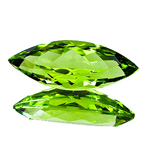
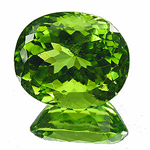
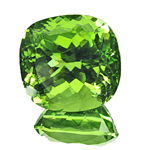
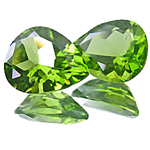
Some peridots of outstanding quality
Origin of name: olivine is named after it´s colour. The word peridot is of Greek origin, but the meaning is unknown
Synonyms and trade names: olivine, chrysolite
Can be confused with: other green minerals like tourmaline (verdelite), chrysoberyl, zircon and grossular garnet. Identification is achieved via optical properties like the refractive index and usually is no problem.
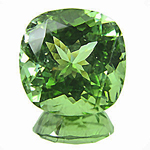
This mint green peridot could easily be mistaken for tourmaline
Furthermore there are synthetic corundums as well as synthetic spinels in peridot colour. Garnet-glass doublets and doublets consisting of colourless synthetic spinel, crown and pavilion, with a green layer of glue in between, have also been observed. All of these synthetic and imitation gems should pose no great threat for the gemmologist.
Locations: members of the olivine group are petrogenetic (rock forming). They are the most common silicate mineral(s) in the upper mantle of the earth.
Peridot, the gem quality of olivine, occurs in several locations. The oldest known deposit is on St. John´s Island (also Zebirget, Sebirget, Seberged or Zabargad) in the Red Sea. This deposit may have been worked as long as 3.500 years ago. The earliest evidence of excavation works on the island is from the early middle ages, when crusaders brought the stones back to Europe.
Other important deposits are in Burma (Myanmar), China, Pakistan and the USA (Arizona).
Unfortunately Arizona peridot often sports a rather unwanted brownish tinge.
Smaller deposits are in Norway and in Hawaï.
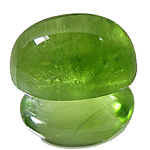
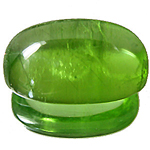
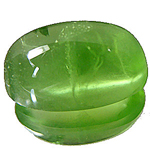
Peridot cabochons from Pakistan
Handling: the chemical composition of peridot may vary considerably, depending which endmember of the group it is closer to. Fayalite-near iron-rich peridots are very susceptible to hydrochloric acid, whereas forsterite- or tephroite-near peridots may not be attacked by it at all.
To be on the safe side, we strongly advise to keep peridot away from all acids, borax, galvanic baths etc.
Apart from this peridot is brittle and sensitive to pressure, so set with care!
Worth knowing: peridot is one of the gemstones, the exact origin of which often can be traced by it´s inclusions. Hair- or needle-shaped inclusions of ludwigite, frequently but understandably misdiagnosed as rutile, is a sure sign of Pakistani origin.
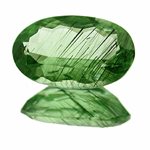
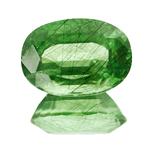
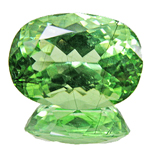
Coarse to hair-like ludwigite inclusions prove the Pakistani origin of these peridots
In peridots from Hawaï, blebs of natural glass can sometimes be seen and Arizona peridot quite often sports inclusions of chrome-spinel and chalcopyrite.
Very often so-called lilypad inclusions can be seen but these are not helpful in origin determination as they occur in peridots from several locations, e.g. Hawaï, St. John´s Island and Arizona.
Peridot shop
 Deutsch
Deutsch